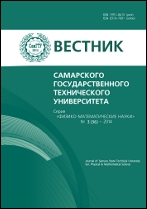|
This article is cited in 3 scientific papers (total in 3 papers)
Differential Equations and Mathematical Physics
The evaluation of the order of approximation of the matrix method for numerical integration
of the boundary value problems for systems of linear non-homogeneous ordinary differential equations
of the second order with variable coefficients.
Message 2. Boundary value problems with boundary conditions of the second and third kind
V. N. Maklakov
Samara State Technical University, Samara, 443100, Russian Federation
(published under the terms of the Creative Commons Attribution 4.0 International License)
Abstract:
We present the second message of the cycle from two articles where the rearrangement of the order of approximation of the matrix method of numerical integration depending on the degree in the Taylor’s polynomial expansion of solutions of boundary value problems for systems of ordinary differential equations of the second order with variable coefficients with boundary conditions of the second kind were investigated.
Using the Taylor polynomial of the second degree at the approximation of derivatives by finite differences leads to the second order of approximation of the traditional method of nets in inner points of the integration domain. In the study of boundary value problems for systems of ordinary differential equations of the second order we offer the previously proposed method of numerical integration with the use of matrix calculus where the approximation of derivatives by finite differences was not performed. According to this method a certain degree of Taylor polynomial can be selected at random for the construction of the difference equations system. The disparity is calculated and the order of the method of approximation is assessed depending on the chosen degree of Taylor polynomial.
It is theoretically shown that
a) for the boundary value problem with boundary conditions of the second and third kind the order of approximation is linearly proportional to the Taylor polynomial used and less than this level by 1 without regard to its parity;
b) at even degree the order of approximation at boundary points of the integration domain is less by 1 than the order of approximation of the inner points;
c) at uneven degree the orders of approximation at boundary points and in inner points of the integration domain are the same and less than this level by 1.
For even degree the method of increasing of the order of approximation by 1 at boundary points of the integration domain to the order of approximation in inner points is performed. The theoretical conclusions are confirmed by a numerical experiment for boundary value problems with boundary conditions of the third kind.
Keywords:
ordinary differential equations, boundary value
problems, boundary conditions of the first, second and third
types, order of approximation, numerical methods, Taylor
polynomials.
Received: January 21, 2017
Revised: March 3, 2017
Accepted: March 13, 2017
First online: May 18, 2017
Citation:
V. N. Maklakov, “The evaluation of the order of approximation of the matrix method for numerical integration
of the boundary value problems for systems of linear non-homogeneous ordinary differential equations
of the second order with variable coefficients.
Message 2. Boundary value problems with boundary conditions of the second and third kind”, Vestn. Samar. Gos. Tekhn. Univ., Ser. Fiz.-Mat. Nauki [J. Samara State Tech. Univ., Ser. Phys. Math. Sci.], 21:1 (2017), 55–79
Linking options:
https://www.mathnet.ru/eng/vsgtu1528 https://www.mathnet.ru/eng/vsgtu/v221/i1/p55
|

|




 Contact us:
Contact us: Terms of Use
Terms of Use
 Registration to the website
Registration to the website Logotypes
Logotypes









 Citation in format
Citation in format 
